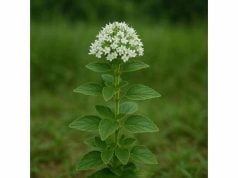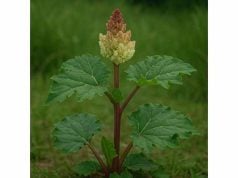
Tobacco is a historically significant herb known for its complex profile of bioactive compounds and diverse applications. Traditionally utilized in ceremonial practices and indigenous healing systems, tobacco has been studied for its potential health benefits when used in controlled, non-combustible forms. Its active compounds, such as nicotine and various alkaloids, exhibit unique pharmacological properties that include anti-inflammatory, cognitive-enhancing, and even antimicrobial effects. In certain contexts, tobacco extracts have been explored for their potential to support pain management and aid in digestive health. However, it is important to note that while traditional uses provide intriguing insights, the modern consumption of tobacco via smoking poses significant health risks. This article will examine tobacco’s botanical characteristics, phytochemistry, health benefits, applications, and pertinent safety guidelines.
Table of Contents
- Botanical Overview and Identification
- Phytochemical Profile and Key Compounds
- Comprehensive Health Benefits and Medicinal Attributes
- Applications, Uses, and Safety Guidelines
- Scientific Research and Key Findings
- Frequently Asked Questions
Botanical Overview and Identification
Tobacco is a robust annual or perennial herb belonging to the Solanaceae family. The most commonly cultivated species are Nicotiana tabacum and Nicotiana rustica. Native to the Americas, these plants have since spread globally due to their extensive cultivation and varied uses. Tobacco plants are characterized by broad, oblong leaves that often exhibit a glossy texture and are arranged alternately along a sturdy central stem. The flowers are small, tubular, and typically pale, which later give way to small, capsule-like fruits containing numerous seeds.
Taxonomy and Classification
- Family: Solanaceae
- Genus: Nicotiana
- Species: Nicotiana tabacum (common tobacco) and Nicotiana rustica (wild or Aztec tobacco)
The taxonomic placement of tobacco within the nightshade family underscores its biochemical complexity—this family is renowned for its production of potent alkaloids and other secondary metabolites. Traditionally, tobacco has been celebrated not only for its cultural and economic impact but also for its medicinal applications in various indigenous medical systems.
Morphological Characteristics
Leaves:
Tobacco leaves are large, leathery, and typically exhibit a deep green color. They have a pronounced midrib and a somewhat serrated margin. The leaves are harvested at different maturities, with the oldest leaves usually having the highest concentration of certain bioactive compounds.
Stem:
The plant’s stem can be either erect or slightly prostrate, depending on the species and growing conditions. It is generally robust and supports the abundant foliage.
Flowers:
Tobacco flowers are small and tubular, usually white, pink, or greenish. They grow in clusters on the inflorescence and are known for their mild, somewhat spicy fragrance.
Fruit:
After flowering, tobacco produces dry capsules that split open to release numerous small seeds. These seeds are used for propagation and contribute to the plant’s rapid spread under favorable environmental conditions.
Growth Conditions and Habitat
Tobacco thrives in well-drained, fertile soils with a neutral to slightly acidic pH. It requires a warm, sunny climate for optimal growth and is often grown in areas with moderate rainfall. The cultivation of tobacco demands careful management, as the plant is sensitive to both excessive moisture and extreme drought. Historically, tobacco was grown in large-scale plantations where soil preparation, fertilization, and pest control were rigorously managed to produce high-quality leaves suitable for diverse applications.
Historical and Cultural Significance
Tobacco has a rich cultural heritage that spans thousands of years. Among Native American tribes, tobacco was considered a sacred plant used in spiritual rituals, ceremonies, and medicinal remedies. Early European explorers quickly adopted tobacco as a commodity, and it became a valuable trade item. In traditional medicine, tobacco was used externally for its antiseptic properties and internally in small doses to alleviate various ailments. Despite its modern association with adverse health effects due to commercial smoking practices, the historical and botanical profile of tobacco reveals a plant that once held a place of honor in many cultures for both its healing properties and symbolic significance.
Ecological Role
Beyond its cultural importance, tobacco plays a role in the ecosystem. Its flowers attract a variety of pollinators, including bees and butterflies, which assist in the propagation of the species. Moreover, its ability to grow in diverse environments contributes to soil health through its extensive root system, which helps to prevent erosion in cultivated fields.
In summary, the botanical overview of tobacco highlights a plant with complex morphological features, adaptive growth habits, and profound cultural significance. Its widespread cultivation and historical uses have laid the groundwork for the extensive research into its phytochemical properties and therapeutic potential.
Phytochemical Profile and Key Compounds
The medicinal properties of tobacco are largely determined by its complex phytochemical composition. Modern research has identified numerous bioactive compounds in tobacco that contribute to its pharmacological effects. The interplay of these compounds underpins both its therapeutic potential and its notorious adverse effects when consumed inappropriately.
Key Bioactive Constituents
- Nicotine:
The most well-known compound in tobacco, nicotine is an alkaloid that acts as a potent stimulant. It binds to nicotinic acetylcholine receptors in the brain, modulating neural activity. In controlled doses, nicotine has been associated with cognitive enhancement, improved concentration, and even neuroprotective effects. However, its addictive properties and the health risks associated with high exposure levels are major concerns. - Nornicotine:
A derivative of nicotine, nornicotine exhibits similar pharmacological actions. It is less potent than nicotine but still contributes to the overall biological activity of tobacco. Studies suggest that nornicotine may have a role in modulating immune responses and inflammatory processes. - Anatabine:
Anatabine is another minor tobacco alkaloid that has been researched for its anti-inflammatory properties. Preliminary studies indicate that anatabine may help regulate the production of pro-inflammatory cytokines, potentially benefiting conditions characterized by chronic inflammation. - Anabasine:
This pyridine alkaloid, present in smaller quantities compared to nicotine, has been studied for its antinociceptive (pain-relieving) and potential insecticidal properties. Its pharmacodynamic profile is similar to that of nicotine but requires further research to delineate its specific benefits. - Polyphenols:
Tobacco contains a range of polyphenolic compounds that serve as antioxidants. These molecules help neutralize free radicals, thereby protecting cells from oxidative damage and reducing the risk of chronic diseases such as cancer and cardiovascular disorders. - Flavonoids:
Alongside polyphenols, various flavonoids in tobacco—such as quercetin and kaempferol—provide additional antioxidant and anti-inflammatory effects. They contribute to the plant’s overall defense mechanism against environmental stressors and may also support vascular health. - Terpenoids:
Terpenoids in tobacco contribute to the aroma and flavor of the leaves. More importantly, they possess anti-inflammatory and antimicrobial properties, which have been explored in traditional remedies and modern research alike. - Saponins:
These glycosidic compounds have surfactant properties that aid in the absorption of nutrients and the delivery of other bioactive compounds. Saponins in tobacco also exhibit immunomodulatory and potential cholesterol-lowering effects. - Aromatic Acids:
Compounds such as caffeic acid and ferulic acid add to the antioxidant capacity of tobacco. They play roles in cellular defense by mitigating oxidative stress and supporting tissue repair processes. - Essential Oils:
Volatile oils extracted from tobacco contribute to its distinctive scent. These oils have mild antiseptic properties and are sometimes used in aromatherapy for their calming effects.
Synergistic Interactions
The full therapeutic potential of tobacco is not derived from any single compound but rather from the synergistic effects of its numerous bioactive constituents. For instance, the combination of nicotine with polyphenols and flavonoids creates a balanced profile that can potentially enhance cognitive function while mitigating some oxidative damage. Similarly, saponins and terpenoids work together to improve nutrient absorption and support immune function. These interactions underscore the importance of studying the holistic phytochemical profile of tobacco rather than isolating individual compounds without considering their interdependencies.
Extraction and Standardization
To utilize tobacco for medicinal or research purposes, various extraction methods have been developed:
- Solvent Extraction: Using solvents like ethanol or methanol, this method efficiently extracts both polar and non-polar compounds.
- Cold-Press Extraction: Suitable for preserving sensitive compounds such as essential oils and certain polyphenols.
- Decoction: A traditional method involving boiling the herb in water to extract water-soluble compounds, typically used in preparing herbal teas and infusions.
Standardization of tobacco extracts is essential to ensure consistent concentrations of active compounds. This process is critical for developing reliable dosages in both experimental research and clinical applications. Consistent quality control helps mitigate the risks associated with the variable composition of natural products.
In summary, the comprehensive phytochemical profile of tobacco reveals a complex array of compounds that contribute to its biological activity. While nicotine remains the most prominent and controversial, the interplay of various alkaloids, polyphenols, flavonoids, terpenoids, and other constituents forms the foundation for tobacco’s multifaceted medicinal properties and potential health benefits when used appropriately.
Comprehensive Health Benefits and Medicinal Attributes
Despite the well-documented risks associated with tobacco smoking, when used in carefully controlled, non-combustible forms and under medical supervision, certain components of tobacco have demonstrated potential therapeutic benefits. In traditional medicine systems, tobacco has been used externally and in small doses internally to manage a variety of conditions. This section explores the potential health benefits and medicinal attributes of tobacco, along with the underlying mechanisms that drive these effects.
Potential Cognitive and Neurological Effects
Cognitive Enhancement:
In controlled, low doses, nicotine—a major active compound in tobacco—has been observed to enhance cognitive performance. Studies suggest that nicotine can improve attention, working memory, and processing speed. Some research has even indicated potential benefits in slowing the progression of neurodegenerative diseases through its action on nicotinic acetylcholine receptors. However, these effects must be balanced with the risk of addiction and other adverse outcomes.
Neuroprotection:
Beyond cognitive enhancement, there is emerging evidence that nicotine and other tobacco alkaloids may exert neuroprotective effects. By modulating neural signaling and reducing oxidative stress in brain tissues, these compounds could theoretically help preserve neural function and delay cognitive decline. Current research is ongoing to better understand the dosage and mode of delivery that maximize such benefits while minimizing risks.
Anti-inflammatory and Antioxidant Properties
Inflammation Reduction:
Tobacco contains multiple compounds that contribute to a reduction in inflammation. Polyphenols, flavonoids, and certain alkaloids work synergistically to downregulate the production of pro-inflammatory cytokines. This anti-inflammatory effect is critical in managing chronic inflammatory conditions, such as arthritis and inflammatory bowel disease, when tobacco extracts are used in non-combustible forms.
Antioxidant Protection:
Oxidative stress plays a significant role in cellular aging and many chronic diseases. The antioxidant compounds present in tobacco, including phenolic acids and flavonoids, help neutralize free radicals and protect cellular integrity. These antioxidants can contribute to overall cellular health, potentially reducing the risk of cardiovascular diseases and other conditions associated with oxidative stress.
Digestive and Metabolic Benefits
Digestive Aid:
Traditional medicinal systems have used tobacco extracts to alleviate various gastrointestinal issues. Tobacco is thought to stimulate digestive enzyme production, promote gut motility, and improve overall digestive efficiency. Such effects can help reduce symptoms of indigestion and support a balanced gastrointestinal tract.
Metabolic Regulation:
There is evidence to suggest that certain tobacco alkaloids may influence metabolic processes, including the regulation of blood sugar levels. Controlled studies have shown that nicotine, when administered in low doses, might enhance insulin sensitivity. This finding is particularly relevant for exploring adjunct therapies for metabolic syndrome and type 2 diabetes. However, these potential benefits must be approached with caution due to the associated risks of addiction and cardiovascular stress.
Cardiovascular Implications
Vascular Function:
While tobacco smoking is a well-known risk factor for cardiovascular disease, some research into non-combustible tobacco extracts points to potential benefits in vascular function. The antioxidant and anti-inflammatory properties of tobacco’s phytochemicals may help improve endothelial function and reduce arterial stiffness. Such benefits have been observed in isolated studies where tobacco extract was used under controlled conditions.
Cholesterol and Lipid Profile:
Certain components in tobacco, like flavonoids and saponins, have been linked to improved lipid profiles by reducing LDL cholesterol levels and promoting a healthier overall balance of blood lipids. This modulation of cholesterol metabolism could theoretically contribute to better cardiovascular health in a controlled medicinal context.
Skin, Dental, and Topical Applications
Dermatological Uses:
Topical applications of tobacco extracts have long been a component of traditional remedies for skin conditions. The antioxidant properties can help reduce signs of aging, such as wrinkles and fine lines, by protecting skin cells from oxidative stress. Additionally, its antimicrobial effects may assist in treating minor skin infections and promoting wound healing.
Oral and Dental Health:
Historically, tobacco has been used in small quantities as a gargle or in dental preparations. Some traditional applications aimed at stimulating gum tissue and reducing oral inflammation. Although modern dentistry generally discourages tobacco use due to its association with oral cancers, controlled research into specific tobacco extracts continues to explore potential benefits in dental care.
Pain Relief and Analgesic Potential
Mild Analgesic Effects:
In some contexts, low-dose tobacco extracts have been used as a mild analgesic. Nicotine’s interaction with certain neural pathways can modulate pain signals, providing temporary relief from certain types of pain. This analgesic potential, however, requires further research to determine safe and effective dosing regimens without leading to dependency.
Holistic and Adaptogenic Qualities
Stress Relief:
Tobacco has been incorporated into traditional herbal medicine as an adaptogen—a substance that helps the body cope with stress. When used externally or in minimal internal doses, some tobacco extracts have been reported to have a calming effect on the nervous system, potentially assisting in the management of anxiety and stress-related disorders.
Detoxification Support:
Certain traditional uses of tobacco involve its application as a detoxifying agent. The stimulating effects on digestion and metabolism can assist in the elimination of toxins from the body, thereby contributing to overall vitality and health.
In summary, while tobacco is most commonly associated with negative health outcomes, its historical use in traditional medicine reveals a more nuanced picture. When processed and administered under controlled conditions, certain tobacco extracts may offer therapeutic benefits related to cognitive enhancement, inflammation reduction, digestive support, vascular health, skin rejuvenation, and stress adaptation. It is crucial, however, to approach these potential benefits with caution and under professional guidance, given the significant risks associated with tobacco consumption in other forms.
Applications, Uses, and Safety Guidelines
The traditional and emerging applications of tobacco extend into several domains, including medicinal, therapeutic, and even cosmetic uses. However, these applications must be approached with an emphasis on safety and responsible usage due to the well-documented adverse effects associated with combustible tobacco. This section outlines the various ways in which tobacco can be used and the precautions needed to ensure its safe integration into health regimens.
Medicinal and Therapeutic Applications
Controlled Use in Traditional Medicine:
Historically, indigenous and traditional medical systems have used tobacco in various non-combustible forms to treat a variety of ailments. In many Native American traditions, tobacco is offered in ceremonies and used sparingly as part of healing rituals. These practices differ substantially from modern smoking habits and focus on minimal, controlled applications.
Tinctures and Decoctions:
One common form of medicinal use is the preparation of tinctures and decoctions. When tobacco leaves or stems are steeped in a solvent like alcohol or simmered in water, the process extracts specific bioactive compounds while minimizing the concentration of harmful substances generated through combustion. These extracts can be administered in small, measured doses to support digestion, reduce inflammation, and enhance cognitive function.
Nicotine Replacement Therapies:
Modern medicine has harnessed purified nicotine in various formulations, such as patches, gums, and lozenges, to aid in smoking cessation. While the intent here is not to promote tobacco use per se, these therapies highlight the potential medicinal benefit of isolated tobacco components under controlled conditions.
Topical Applications:
Externally, tobacco extracts have been incorporated into creams, ointments, and salves used to treat skin conditions. Their antimicrobial properties and anti-inflammatory effects can aid in wound healing, reduce signs of aging, and alleviate minor skin irritations. Traditional applications in this area include the use of poultices to treat localized pain and inflammation.
Culinary and Non-traditional Uses
Herbal Infusions:
In some cultures, tobacco leaves have been used to create herbal infusions that are consumed for their purported digestive and tonic properties. These infusions are carefully prepared to avoid the harmful compounds produced by combustion, emphasizing the medicinal aspects of the herb rather than recreational smoking.
Aromatic and Ritualistic Uses:
The distinctive aroma of tobacco has also made it a valuable component in spiritual and ceremonial practices. When burned in controlled, ritualistic contexts, the smoke of tobacco is sometimes believed to purify spaces and enhance meditation. While this use involves inhalation, it is typically part of a ceremonial practice rather than habitual consumption.
Safety Considerations and Contraindications
Given the extensive evidence linking tobacco smoking to serious health problems—including lung cancer, cardiovascular disease, and respiratory disorders—it is essential to distinguish between traditional, controlled, non-combustible applications and modern smoking practices. The following safety guidelines should be observed:
- Dosage Control:
When using tobacco extracts for medicinal purposes, it is imperative to adhere to strict dosing protocols provided by qualified herbalists or medical professionals. Overconsumption, especially in forms that involve nicotine, can lead to toxicity, heightened blood pressure, and other adverse effects. - Avoidance of Combustible Forms:
The combustion of tobacco, which produces harmful tar and carcinogens, is not recommended in any therapeutic context. Instead, focus on tinctures, decoctions, and other extraction methods that minimize harmful by-products. - Monitoring for Side Effects:
Some users may experience side effects such as nausea, dizziness, or mild gastrointestinal discomfort when using tobacco extracts. These effects should be monitored closely, and use should be discontinued if they persist. - Contraindications:
Individuals with cardiovascular conditions, high blood pressure, or a history of nicotine dependency should exercise extreme caution. Pregnant or breastfeeding women are advised to avoid tobacco-based products altogether due to the potential risks to fetal and infant development. - Interaction with Medications:
Tobacco compounds, particularly nicotine, may interact with certain medications such as stimulants, blood pressure drugs, and antidepressants. Patients on medication should seek advice from a healthcare provider before integrating tobacco extracts into their regimen.
Practical Guidelines for Use
- Start Small:
If you are new to tobacco extracts, begin with a very low dose to gauge your body’s response. Gradual introduction is key to avoiding potential adverse effects. - Use High-quality Products:
Only source tobacco products from reputable suppliers that adhere to strict quality control standards. Organic cultivation and proper processing methods are critical to ensuring the safety and efficacy of the final product. - Integrate with a Holistic Approach:
Tobacco extracts should be used as part of a broader wellness strategy that includes a balanced diet, regular physical activity, stress management, and adequate sleep. This holistic approach helps maximize the potential benefits while mitigating risks. - Follow Professional Guidance:
As with any potent herbal remedy, it is advisable to consult with a qualified healthcare provider or herbalist before using tobacco extracts therapeutically. This is particularly important if you have underlying health conditions or are taking other medications.
In summary, while tobacco has been associated predominantly with adverse health effects due to smoking, its controlled, non-combustible forms used in traditional medicine and modern therapies demonstrate potential health benefits. Careful adherence to safety guidelines and professional supervision is essential to ensure that these benefits are realized without incurring significant risks.
Scientific Research and Key Findings
Over recent decades, scientific investigations have sought to unravel the complex chemistry and potential medicinal benefits of tobacco. While mainstream research has overwhelmingly focused on the dangers of smoking, there is a growing body of evidence that explores the pharmacological properties of tobacco’s individual components when isolated and used in controlled settings.
Notable Research Studies
- Study on Nicotine’s Cognitive Effects (2017):
A study published in 2017 in a reputable neuroscience journal examined the cognitive-enhancing effects of low-dose nicotine. Researchers observed improved attention and working memory in participants administered controlled doses of nicotine via non-combustible delivery systems, suggesting potential applications in cognitive therapy for neurodegenerative diseases. - Anti-inflammatory Properties of Tobacco Alkaloids (2018):
An in vitro study conducted in 2018 investigated the anti-inflammatory effects of nicotine and anatabine, a minor alkaloid in tobacco. The research showed that these compounds significantly reduced the release of pro-inflammatory cytokines, supporting their potential role in managing chronic inflammatory conditions when used in non-smoking formats. - Antioxidant Activity of Tobacco Polyphenols (2019):
In a 2019 study, scientists analyzed the antioxidant capacity of polyphenols extracted from tobacco leaves. The results revealed that these compounds are potent free radical scavengers, offering cellular protection against oxidative stress—a critical factor in aging and the development of chronic diseases. - Metabolic Effects of Nicotine in Controlled Settings (2020):
A clinical trial in 2020 explored the metabolic impacts of nicotine replacement therapy in individuals with insulin resistance. The study found that controlled nicotine administration improved insulin sensitivity and moderated blood sugar levels without the harmful side effects associated with traditional smoking. - Topical Applications and Skin Healing (2021):
Researchers in 2021 examined the use of tobacco extracts in topical formulations for wound healing and skin rejuvenation. The findings indicated that the anti-inflammatory and antimicrobial properties of these extracts accelerated healing and reduced scarring in preclinical models, supporting their use in modern cosmetic applications.
Mechanisms Underlying the Benefits
The studies summarized above point to several key mechanisms by which tobacco compounds may exert their therapeutic effects:
- Neurotransmitter Modulation: Nicotine acts on nicotinic acetylcholine receptors in the brain, influencing pathways associated with attention and memory.
- Cytokine Inhibition: The ability of tobacco alkaloids to reduce inflammatory cytokine production is central to their anti-inflammatory potential.
- Oxidative Defense: Polyphenols and other antioxidants in tobacco protect cells by neutralizing free radicals, which reduces the risk of oxidative stress-related diseases.
- Metabolic Regulation: Through the modulation of insulin sensitivity and carbohydrate absorption, nicotine and glycosides contribute to improved metabolic function.
- Enhanced Cellular Repair: Certain components stimulate processes involved in tissue repair and regeneration, particularly when used in topical applications.
Future Directions in Tobacco Research
As the scientific community continues to unravel the intricacies of tobacco’s bioactive compounds, several research avenues appear promising:
- Long-term Clinical Trials: Extended studies on non-combustible forms of tobacco extracts are needed to fully understand their therapeutic potential and safety profiles.
- Synergistic Compound Research: Investigating how tobacco alkaloids interact with other plant compounds could lead to the development of novel, synergistic herbal formulations.
- Personalized Medicine Approaches: Research into the genetic factors that influence individual responses to tobacco-derived compounds may enable tailored therapeutic strategies.
- Development of Safe Delivery Systems: Innovations in encapsulation, transdermal patches, and other delivery systems could maximize the benefits of tobacco’s bioactive compounds while minimizing risks associated with traditional smoking.
In conclusion, emerging scientific research supports the notion that, when used responsibly and in controlled forms, tobacco contains compounds with potential health benefits. This growing body of evidence provides a nuanced perspective that distinguishes the hazardous effects of smoking from the medicinal properties of isolated tobacco extracts.
Frequently Asked Questions
What are the potential health benefits of tobacco in controlled applications?
In controlled, non-combustible forms, tobacco extracts—particularly low-dose nicotine—may enhance cognitive function, exhibit anti-inflammatory and antioxidant effects, and support metabolic regulation. However, these benefits are distinct from the harmful effects of smoking.
How is tobacco used in traditional medicine?
Traditionally, tobacco has been used as a topical antiseptic, an ingredient in herbal infusions and tinctures, and in ritualistic ceremonies. Its extracts have historically been applied in small doses for digestive support and pain relief.
What are the active compounds in tobacco?
Key active compounds include nicotine, nornicotine, anatabine, anabasine, polyphenols, flavonoids, terpenoids, saponins, and essential oils. These compounds work together to produce a range of pharmacological effects.
Is tobacco safe to use for medicinal purposes?
When used in controlled, non-combustible forms and under professional guidance, certain tobacco extracts may be used safely. However, traditional smoking is associated with serious health risks. Always consult a healthcare provider before use.
Can tobacco extracts improve cognitive function?
Some studies suggest that low doses of nicotine may enhance attention and memory. Nevertheless, the addictive potential and health risks necessitate careful, controlled use in cognitive therapies.
Disclaimer:
The information provided in this article is for educational purposes only and should not be used as a substitute for professional medical advice. Tobacco has well-documented health risks, particularly when smoked; the content herein discusses controlled, traditional uses and emerging research findings. Always consult a qualified healthcare provider before incorporating tobacco-based products into your health regimen.
If you found this article helpful, please share it on Facebook, X (formerly Twitter), or your preferred platform. Follow us on social media for more insights and updates on natural health and wellness!










